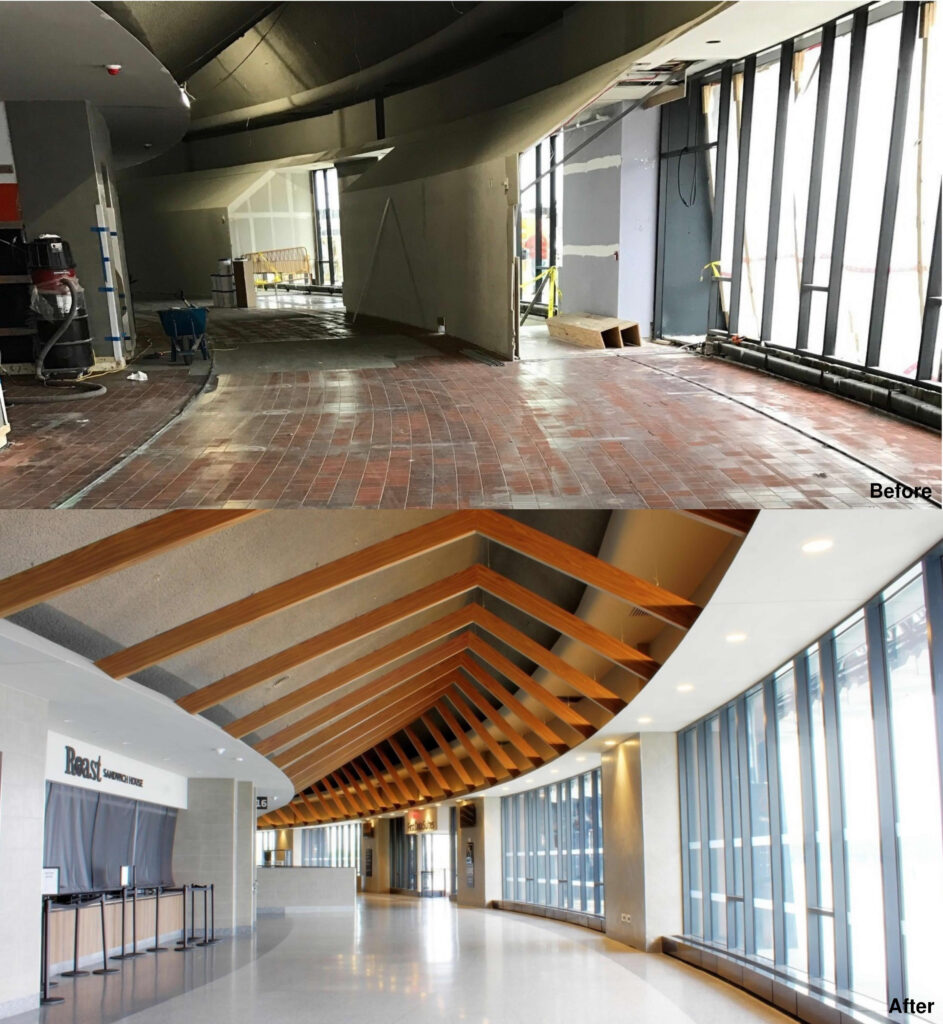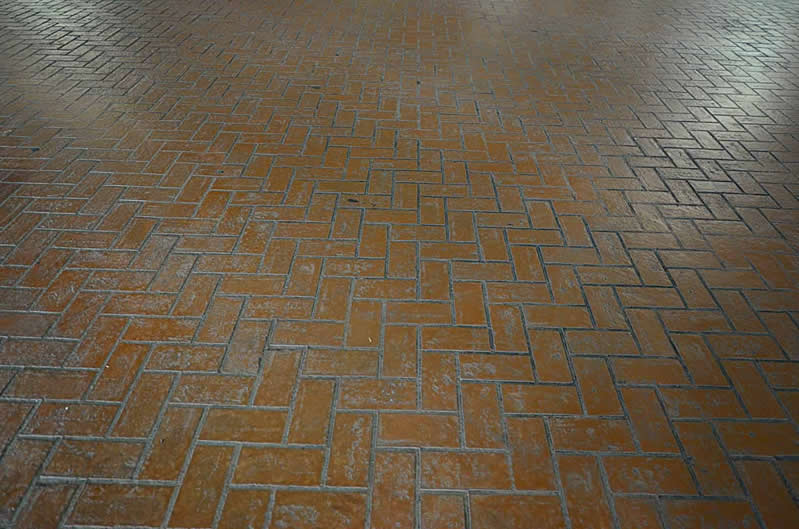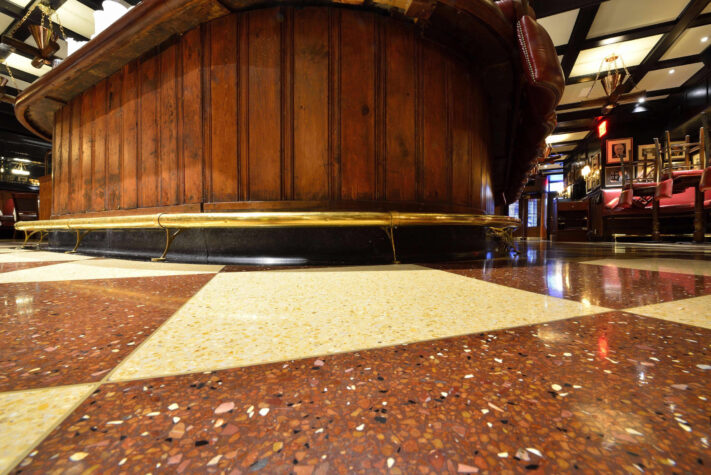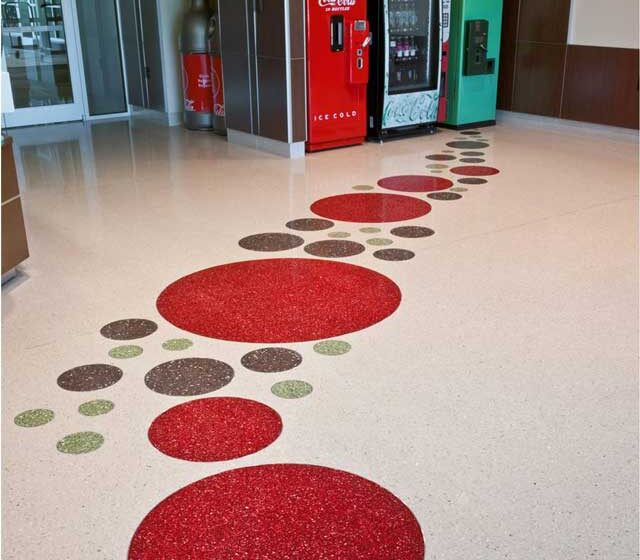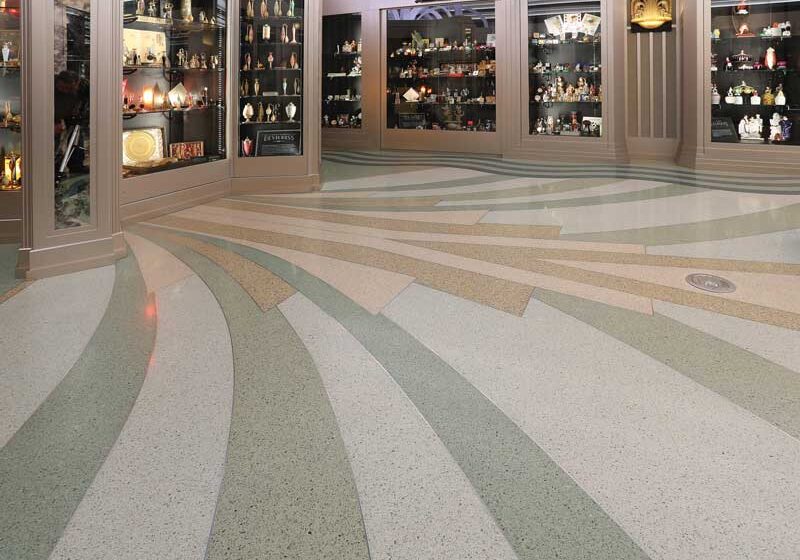We asked some of our member terrazzo contractors for their advice based on their experience with installing terrazzo over a variety of old substrates.
One less floor to demo, one less slab to pour
Knowing when and how you can confidently install terrazzo over the existing substrate requires experience and knowledge of terrazzo. The good news is this can pay off in saving construction costs and time considering the cost and time for demolition and pouring a new concrete slab.
“Main advantages are not having to tear out the old floor, and that it’s shovel ready, ready to work,” said Greg Sweetin, president of Williams Tile & Marble, Smyrna, GA. Many of the floors we might apply terrazzo over are on a mud bed, not just on concrete, so “saving the costs of the demolition of a 1. 5-inch mortar bed saves the client a good bit of money,” he said.
Keeping in the old floor can be the difference between being able to install terrazzo within budget or not. At Charleston International Airport in 2016, some 90,000 square feet of epoxy terrazzo was installed successfully directly over brick pavers. The savings for leaving in the old floor was estimated at over $1 million, according to John Wingo, senior project manager with the David Allen Company of Raleigh, NC. “The savings are there, if the old floor is sound.” LINK
Leaving the old floor in place is also an environmental plus, saving tons of waste from going to landfills, and avoiding dust, noise, and energy use.
Bond, Terrazzo Bond
All our contractors agreed: if a hard-surface floor is bonded, sound, and secure, there’s a good chance you can put terrazzo in over it.
“Just as with pouring terrazzo over concrete, be sure the existing substrate is strong and structurally sound,” said Mr. Sweetin, whose company has installed terrazzo over various substrates, including granite and marble. Loose tile and broken grout are indications of potential problems, and terrazzo shouldn’t be applied straight over a cracking floor, he cautioned, nor over any kind of “soft goods”: carpet, VCT, or vinyl.
Matt Holdsworth, project manager and estimator with Zonca Terrazzo & Mosaic LLC in Armonk, NY, noted that many self-leveling products are not compatible with terrazzo; the compressive strength of these products is inadequate for the task. For example, gypsum-based floor materials can lack structural strength, and bonding epoxy to it can be questionable. The vibration from grinding terrazzo can also disintegrate the gypsum.
Test for Bonding
Whether an old substrate is solidly bonded to the floor below can be easily determined by simple tests. The first consideration is how much cracking is visible in the floor and determining whether it’s a deal-breaker or not, Mr. Wingo explained. Dragging a pipe or chain across the floor or bouncing a golf ball on it can reveal hollow spots to the trained and experienced ear.
Terrazzo Over Terrazzo
If an old terrazzo floor is in good shape but the client wants a fresh look, new terrazzo can be installed over either cement or epoxy terrazzo. If the old floor has lost its bond to the concrete, spider web cracks are a telltale sign, Mr. Wingo advised. If old terrazzo shows minimal cracking, the cracks may be successfully treated with epoxy and a moisture membrane system installed to keep any cracks from telegraphing into the new floor.
Cement terrazzo is porous, and is more susceptible to staining, Mr. Wingo noted, citing an example of old terrazzo that had had carpet glued onto it. The glue had soaked in and the stain couldn’t be removed; the floor had to be replaced.
Old Substrate Prep
Bond-testing will identify problem areas that need to be removed and refilled with epoxy. Then a slurry coat—a thin layer of epoxy resin and sand— applied to the surface can smooth out any uneven areas and grout joints.
“Like a new concrete substrate, epoxy underlayment mixed with sand is like steel,” Mr. Holdsworth stated. “It’s not going anywhere.”
A moisture-control system and a 100-percent elastomeric membrane is often applied before the terrazzo is poured.
Different Elevations
Mr. Holdsworth recounted that his company had recently installed a new terrazzo floor over a poorly installed terrazzo floor put in by a non-NTMA contractor just six months before. Around the doors and elevator saddles, where the new floor had to meet existing elevations, they chopped out three four-foot half-moon shaped areas. They flushed the new terrazzo to meet the previous floor and blended it so the difference in elevation is unnoticeable.
Mr. Wingo advised the same for elevation issues with brick pavers. “It’s still less hassle than tearing it all out,” he concluded.
Contact NTMA technical director Gary French at gary@ntma.com or (800) 323-9736 for complimentary guidance with your terrazzo project.
Examples of substrates that may be suitable to accept a terrazzo installation:
Quarry tile
Brick pavers
Marble
Stone
Tile
